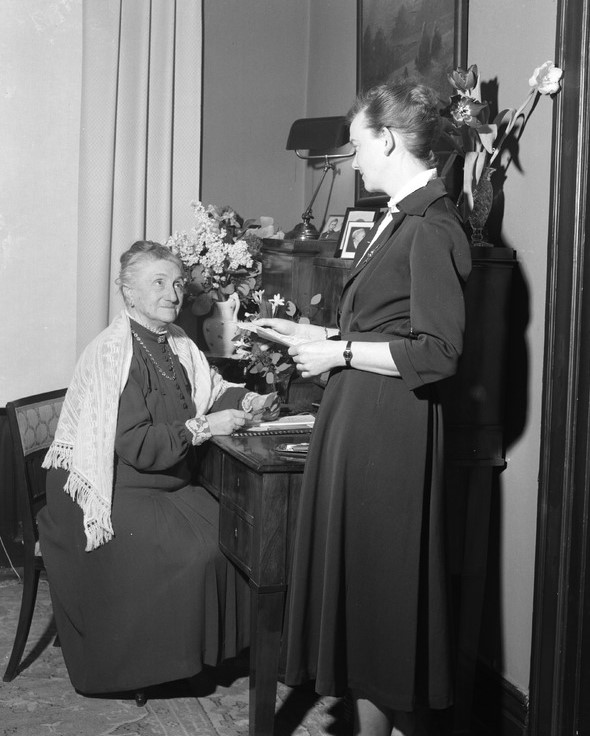Léonie Deshayes was an office manager, suffrage advocate and donor.
Léonie Deshayes was born in Lund in 1871 as the youngest of four siblings. Their father Amand Deshayes was born in France in 1817, had settled in Copenhagen, and had married Thora Wilhemina Mencke, a Dane. When Amand Deshayes took over one of Lund’s first industries, the French steam mill in 1870, the family moved to that town. They then moved in 1874 to Kollinge outside Hässleholm where Amand Deshayes continued to run a mill business.
After his death in 1876 , their mother and brothers took over the company, and as a 15-year-old, Léonie Deshayes started work there as a clerk. The company was sold in 1892 and Léonie Deshayes moved to Helsingborg where she gained employment as a cashier at the Helsingborg Gummifabrik AB (later AB Tretorn). Some years into the new century, she advanced to be office manager, a position that made her known in Helsingborg. She enjoyed the trust of the factory’s management. In an obituary published in Helsingborgs Dagblad, it was noted that she owned a ”remarkable gift for numbers” of which the company made full use. Her knowledge of economics was to be taken advantage of by several associations of which she was a member. Among other things, she acted as the accountant for a local branch of the suffrage association Landsföreningen för kvinnans politiska rösträtt (LKPR).
Léonie Deshayes became the first woman in Sweden to be nominated to a place on the town council. New legislation in 1909 had made this possible, and in January 1910, four associations in Helsingborg – Fredrika-Bremer-Förbundet, Landsföreningen för kvinnans politiska rösträtt, Kristliga föreningen av unga kvinnor (KFUK) and Vita Bandet nominated Léonie Deshayes as their candidate to the conservative Allmänna valmansförbundet (AVF). However, after various organisational problems, she withdrew her candidacy. It was instead Sara Thåström who in 1912 became the first woman to take place in Helsingborg’s highest decision-making assembly. When another member of the town council resigned from his assignment in 1913, Léonie Deshayes joined the town council as the second woman member.
Like many other politically engaged women at the beginning of the 1900s Léonie Deshayes had a passion for the allotment gardens movement, and she was one of the pioneers in Helsingborg. She sat on the board of the Föreningen Helsingborgs Koloniträdgårdar u.p.a. from its start in 1905 until at least 1937, with the assignment of the association’s economic controller. Kristina Borg was also active on the board at the start. Léonie Deshayes was also engaged in Fredrika-Bremer-Förbundet’s branch in Helsingborg, for which she for several years was the vice chairwoman and cashier.
Léonie Deshayes enjoyed trading with shares, which led to her amassing a considerable fortune, and when she finished her employment at the rubber factory in the 1930s, she devoted herself whole-heartedly to the stock market. She spent the summers in her summer residence at Mölle on the coast.
Léonie Deshayes lived for several decades in a flat in the district of Olympia, together with her housekeeper since 1922, Anna Wiezell. In 1929, the 17-year-old orphan Britta Schill moved into their household, and she came to be very close to Léonie Deshayes. Another close friend was her sister-in-law Astrid Prip from Danmark, who stayed for long periods in Léonie Deshayes’ homes in both Helsingborg and Mölle.
During the latter part of her life, Léonie Deshayes donated large sums of money to among other good causes a fund at the University of Lund financing research on cancer, and she also established a foundation for orphaned children. In her will, she distributed her money to various causes, among them cancer research at Lund University. She also supported Fredrika-Bremer-Förbundet and donated money to a home for orphans in Helsingborg. Altogether, she donated 3.7 million kronor to various good causes of general benefit. She valued the contact and social intercourse with her brothers’ children and their families, not to mention other relatives, and in her will, no fewer than 45 relatives are mentioned as well as six other people close to her.
Léonie Deshayes died in October 1959. She is buried in the same grave as her parents at Assistensens Cemetery in Copenhagen.












